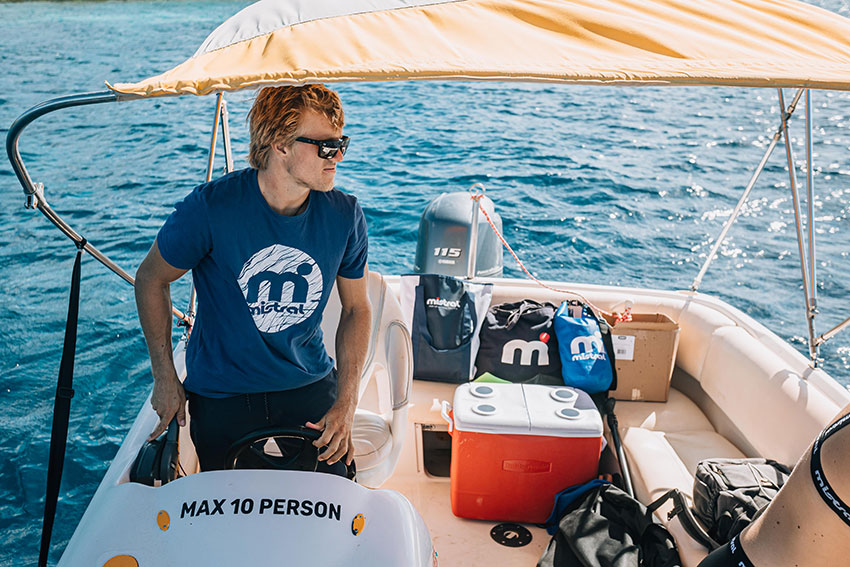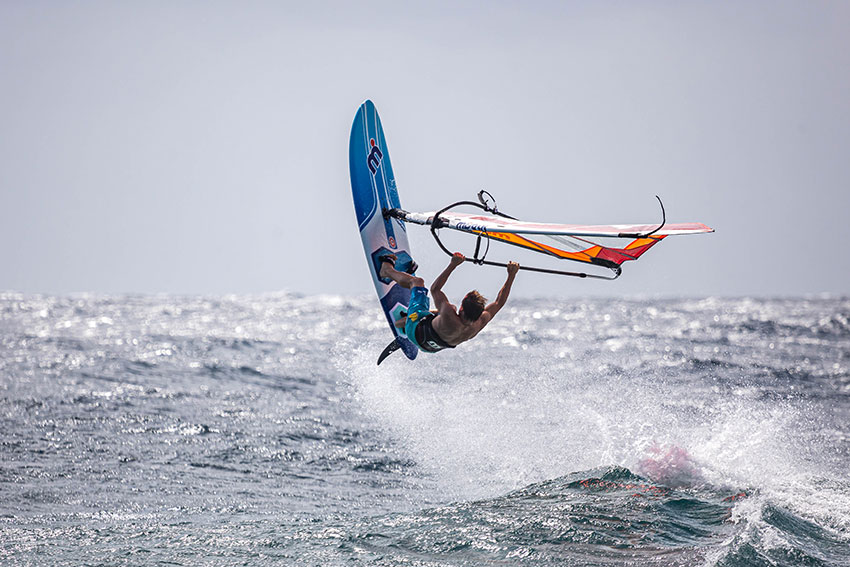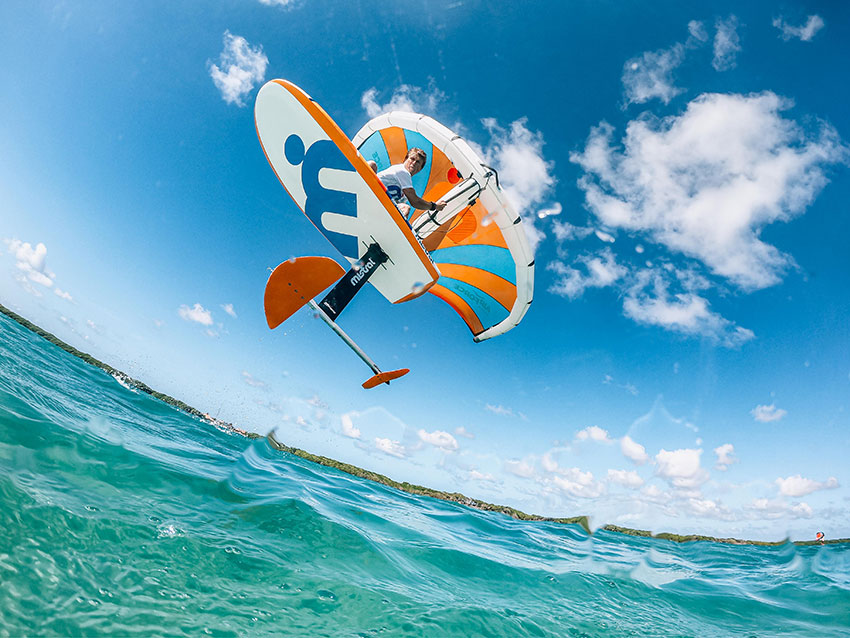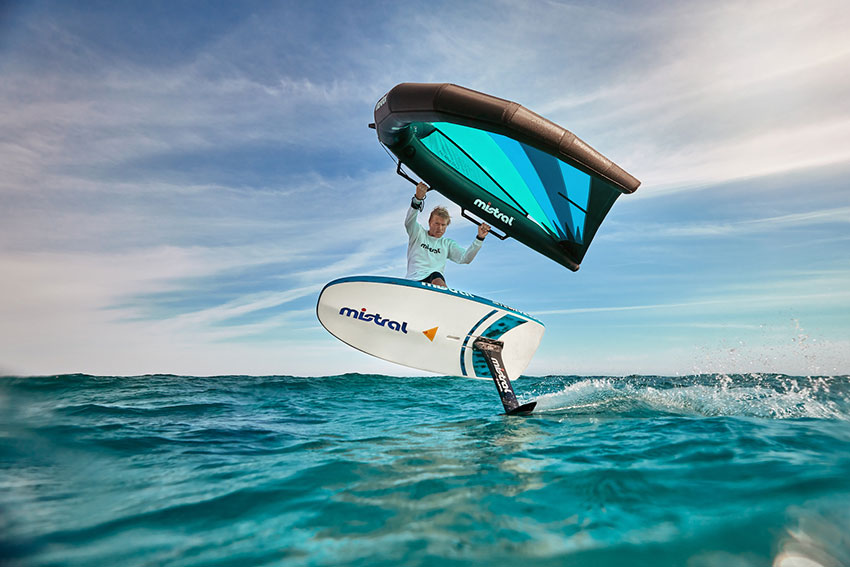Steve West talks with Sil Romeijn, Mistral’s Team Rider
Nothing polarises a life more than island life, especially when born on a speck in an expanse of cobalt blue; the further away from anywhere in being nowhere, all the better. Tropical islands often give rise to a Bohemian life, where water babies grow to become watermen and women, a touristic water sports career, often an existential reality of doing what they do best. Infected by visitors who often overrate what lies beyond island life, islanders visit their protectorate countries, many returning home as sea turtles navigate their return to their island birthplace.
Mistral Team Rider Sil Romeijn is such a person. You might think at 24, living on a 42′ yacht with his dog Parker, existing with no car, just a bike, and few needs and wants or any form of career path, he’s either independently wealthy or has tuned in and dropped out. A philosophical person would say his life is rich with time to live life to the fullest, being on the water. The truth is that he has minimal needs, prioritizing a life on the water.
Born of Dutch parents who, during their mid-twenties, had delivered a yacht to the Caribbean Island of St Martin, forged a living chartering their yacht, of which Sil became a part. When he turned eight, his father sold the yacht, and they moved to the Caribbean Island of Bonaire, offering access to a Dutch education system future-proofing educational advancement in the Netherlands.
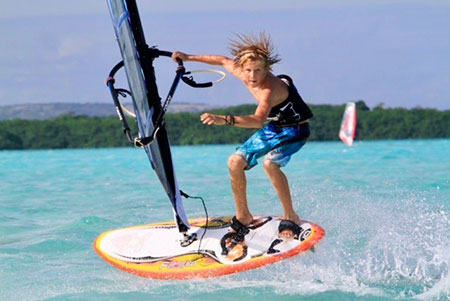
‘Living in St Martin, I grew up on the water. When we visited Bonaire, I saw, for the first time, a kid’s 1.5 m windsurfing rig. I was super-stoked, as I had no idea they made them that small. My sister and I had a few lessons, and I sailed for the whole week to the point where my hands were blistered. When we moved to Bonaire, I was windsurfing almost daily over the shallow, warm, turquoise waters. The trade winds here are perfect for the sport, the Valhalla for windsurfers. Every day after school, I was on the water.’
Ripping it up as a grommet, Sil would turn to kitesurfing along with countless others.
When he approached fourteen, many friends were now sponsored and competing; paradoxically, windsurfing had now been overrun by kitesurfing, gaining traction globally. A local school offered lessons out of his budget. Leading up to the 2013 Kite Ride Bonaire, sponsors wanted youth-aged kiters on the water and set about selecting 20 island kids for lessons. ‘I was straight onto this; I submitted my application and attended an audition. I got some training beforehand and was power-looping the kite for the assessors and was selected. From that moment, I transitioned full-on into kitesurfing. I worked at the local kite school for USD 25 a day to pay off equipment, preparing kits, working on the support boats and finally, as an instructor. I competed in Aruba and a Dutch Championship, and when I was seventeen, I moved to the Netherlands.’
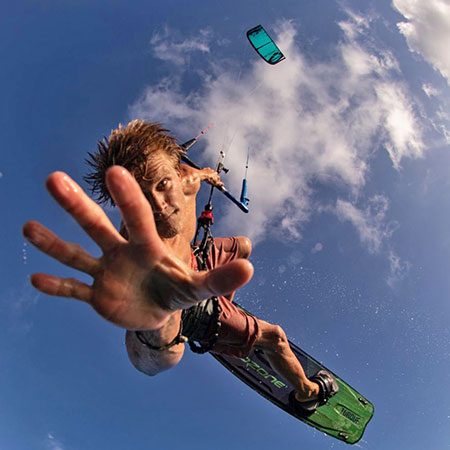
After nine years of Bonaire, off-island life provided the opportunity to meet new people, further his education and seek opportunities; a time that would be transformative. A kitesurfing friend offered him a place to live in Zandvoort, and he was introduced to Ozone Benelux importers of Ozone, F-one, Lokahi and Manera. He would borrow gear, use it and sell it at season end based on a price they wanted and then kit up again from new and worked part-time as a kitesurfing instructor.
“Sil prefers expressionism over competition and experiences over podium aspirations.”
He turned to a study of carpentry and majored in wooden boat building. During his internship, he purchased a yacht with a loan from his father and moored his yacht at the boatyard and workshop, living here for over eighteen months. Providing kitesurfing and catamaran lessons to supplement his income, he would graduate with honors. ‘It was all bizarre at first. Everyone I met assumed I was familiar with all aspects of Dutch life and what being Dutch means. I don’t, so they think I must have lived in a cave all my life. It’s getting better. During my studies, they called me the Antillean being from Bonaire and that I speak Creole, which I sometimes use to confuse others.’
The greatest challenge for sub-tropical watermen and women is adapting to cold winds and water, wearing a wetsuit, dark waters, inconsistent winds, tides, the unpredictable nature of Northern European weather, and the season’s extremes. ‘I wore a 5/2 suit, summer and winter for the first few years, but I love extreme conditions. In Bonaire, I owned just a 9 m kite; now I need a full quiver. Riding the North Sea makes me ride aggressively, which can lead to injuries. I once broke my leg kite looping, resulting in a compound fracture of my tibia and fibula. It taught me some valuable lessons during my recovery, over and above the pain of the injury.’
Living aboard his yacht in Haarlam, a twenty-minute bike ride from Zandvoort and Bloemendaal, while working at Mifune Beach instructing kitesurfing, he received a call from his boss saying someone was looking for a blonde model.
‘I had never modelled, and it was not my thing, nor even interviews; I get camera shy and blank out, but when they said it was for Mistral, I listened, as I had not heard of this name since my Dad used to talk about it. I would have said no if it were Mystic or another brand.’
His first photoshoot with Mistral windsurfing boards and rigs impressed him with top quality and high performance. His debut modelling session was a success, ending in a very positive outcome in which a relationship with Mistral is now nearing a four-year term, during which wingfoiling has developed into the new trend sport and now his primary sport.
Sil continues to winter in Bonaire, travelling with Mistral equipment and harvesting imagery for the brand. ‘There aren’t many studies you can pursue in Bonaire. Weirdly, graphic arts, photography, videography and editing are on the list of vocational studies and many of my friends are involved in this industry. I asked one of my best friends, a photographer, to capture images of me for Mistral. We sent the photos, and they were stoked and wanted more. I invited my sister, three years older, to get involved with some of the shoots. When we finally met the Mistral management in Holland, they were super-enthusiastic. They wanted us to be a couple in shots, but that would not happen as we’re brother and sister! We received some payment and selected whatever clothing we wanted; it was the first time I felt sponsored in the real sense, even though I had an arrangement with Ozone. It was a childhood dream, really.’
In the second year of sponsorship, Sil was riding Mistral’s first generation of wingfoiling equipment. As a once fully committed windsurfer, then kitesurfer, his foiling began with pump-foil before stepping into wingfoiling. ‘I recently read a meteorological truism that states the faster a weather pattern forms, the quicker it goes. People are surprised at how fast wingfoiling has flown up into the sky, as it were, but it’s hard for me to imagine it will fly by at the same pace it grew.
The sport will grow as plenty of people are yet to enter the sport, and many are still learning. Places once windsurfing hot spots are now populated with wingfoilers. The sport continues to surprise in new ways as skills and equipment evolve. My girlfriend instructs in Haarlam, and their school had 110 students in July. While the foil idea is intimidating for many, the learning process is friendly, and the instructional strategy is geared toward safety first.
Windsurfing is one of the most challenging wind sports to learn and progress. Wingfoiling’s easier to learn, even more so than kitesurfing, without lessons if you have pre-existing skills. Kitesurfing is prohibited in many areas, and the risk management required is higher. Wingfoiling’s wide accessibility to water space is a massive positive so that water previously off-limits can be used. Then there’s the diversity of foiling sports: pump, sup, wing, windfoiling, and all disciplines. Pre-pandemic, everyone wanted to learn kitesurfing. Now it’s wingfoiling.
Wingfoiling has resulted in a growing new community online, at the local lake or beach, so that at the weekend, they only want to talk about and do this new thing. The sport has yet to boil over into Holland and other parts of Europe, but the feedback I am getting from kitesurfers is a growing sense of ‘missing out’ on this new magical feeling. Kitesurfing is a fantastic sport, but it’s risky and demands space, putting it in competition with wingfoiling, which has fewer limitations. It’s these advantages that make wingfoiling the ‘go-to’ alternative. Many of my friends have sold off their kitesurfing kits and are now wingfoiling (in the same way windsurfers sold out to kitesurfing).‘
The history of windsurfing taught us that providing guided lessons with a ‘try before you buy’ approach was hugely successful. Retailers were in on this strategy, and reinstating the original windsurfing simulator could teach board and wing skills to those without wind or board sport skills. Globally, if even 50% of kitesurfing schools and resorts were to adopt wingfoiling, the sport would expand rapidly, and it’s reasonable to assume the number would be higher than this.
Mistral now collaborates with Italian foil specialists SAB as part of a strategy of cooperation and acknowledgement that this is the most intelligent pathway given the number of existing fabricators and designers so far ahead of the curve regarding investment and technological understanding. When asked about this strategy, Sil is pragmatic.
‘If Mistral wants to be in foiling, it’s better to offer a branded product immediately associated with high-end quality and a stand-alone foil maker of quality. Lovers of Mistral get to ride the logo and can purchase complete kits with board, wing and foil, which SAB does not offer.’
Contributing to Mistral’s R&D team and sharing his knowledge is something he’s always keen to provide. ‘Team riders must feel part of the brand and included in some design discussions; after all, we are amongst the buyers, on the water and have our finger on the pulse, and we can also influence others. The water is my office, the same way as the physical office is the office of others within the company. We are a team; everyone should feel valued and part of the brand’s journey. All aspects of the brand are essential to build it together, not alone. Trying to work independently in the company to prove one’s worth is the wrong approach; working together is the best way.’ In short, the divide between those in the office and those on the water must be a shallow trench, not a deep void into the abyss; water people are what water brands are all about.
Whilst competing is one way to draw attention to Mistral or any brand, these days, it is more about aspirational imagery, travelling to remote destinations and sharing the journey like a stranger in a strange land. ‘I would love to wing foil Peru or Mexico, maybe Cape Verde or somewhere in the Pacific, capture great images and create storylines; I think this is where brands can distinguish themselves away from the relatively shallow gene pool of competition.’ This approach is popular with the media and those fascinated to see what’s possible by jumping on a plane and taking a chance. The challenge is in being creative to capture the imagery needed.

